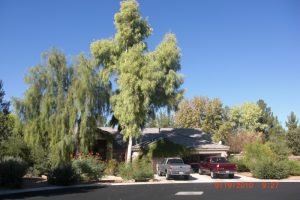Q. A little over a year ago we bought our current house in North Las Vegas. The
folks who sold us the house took a large slope (facing West) in the back of the
property and put a retaining wall to level the yard. Plants in that area are
dying. After reading your comments in the paper, we are equating this space to
a “giant pot” cooking everything to death. We are fairly certain there are
irrigation problems that are contributing to the current situation and will get
addressed once we have a plan in place.
A. My comments were made about containers, not soil in the ground. Soil in the
ground stays cooler than containers because extra heat is routed to the surrounding
and deeper soil. Small containers (20 gallons or less) directly in the sun can
get overly hot on the west and south sides of a home. I was suggesting using
larger containers in those places and watering them daily (if they can drain)
before the soil and roots get hot. The use of surface mulch 2 to 3 inches deep
also keeps soil in the ground from getting too hot. I suggest increasing the
depth of any surface mulch used in that area.
Most of your plant problems are probably related to irrigation and plant selection for those areas. The south and west sides of a home are typically in the hottest spots. Make sure you use deciduous plants to cool the west and south sides of a home. Shading doesn’t include the roof but rather the walls and windows. You can always add plants for interest later as you figure out your personal “needs and wants” of your landscape.
Two-story homes may require larger trees than single-story homes.

This can mean more water is needed on those sides. On these south and west sides make sure these plants are “heat tolerant”. Trees and shrubs on this side should be “bulletproof” to the heat (120F) and cold (20F) we can experience. This is the reason I suggest using tried-and-true “desert plants” for these areas. Trees should be a distance apart, and from the house, of at
least three fourths of their mature height. Smaller shrubs of various sizes,
colors and textures are randomly planted beneath these trees to create
interest and make use of the water supplied.
Other things to consider on that side that don’t use water include the use of different-sized rock or boulders, painting the walls different colors, murals, or statuary. Use your imagination or hire someone to work with you who is creative.